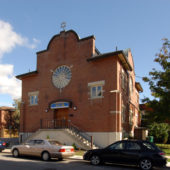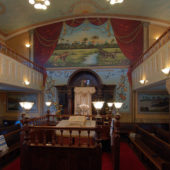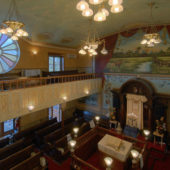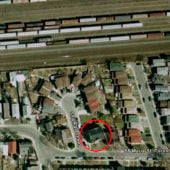One of West Toronto’s landmarks. The oldest synagogue building still in use as a synagogue in Toronto.
Built in 1911, the Knesseth Israel Synagogue, more commonly known as the Junction Synagogue, is today Toronto’s oldest synagogue still in operation. Located on the corner of Maria and Shipman streets in west Toronto, the synagogue acquired its name thanks to its proximity to railway lines and a bustling business district.
The late 19th and early 20th century Jews of Toronto, mostly recent immigrants from eastern Europe, first met in a home in west Toronto. When this arrangement became inadequate, plans were made to construct a purpose built facility for worship under the direction of the architectural firm, Ellis and Connery.
The result was an unassuming red-brick building with little ornamentation or architectural embellishments. Instead, the round windows are the main feature of the exterior and they are divided into 18 segments, the numerical value of the Hebrew word, “chai” which means life. A two-sided staircase leads visitors up to the main entrance. Inside, the synagogue observes the traditional layout of an orthodox Ashkenazi house of worship, with the Ark, or Aron Kodesh, placed in the eastern wall facing Jerusalem and the platform, or bimah, located in the middle of the main hall. Above, there is a three-sided balcony for women to be seated during services. Both the ark and the bimah are handcrafted from oak, probably by cabinet makers who were part of the synagogue’s first congregations. Oak benches situated around the bimah contain drawers allowing members to store their sidduram, tallisot and prayer books. Additionally, the benches each have a Magen David, or Star of David, carved into them.
Perhaps the synagogue’s most noteworthy interior features are the murals painted on the walls above the Aron Kodesh, on the ceiling and around the main hall. The painting of the walls was said to be delayed until after World War I when enough funds could be raised. The synagogue then hired European painters who created murals using classic Jewish religious symbols and motifs. Unfortunately, some oily rags caught fire and nearly ruined the endeavor. Discouraged, the painters quit the job but at some point others were hired to finish the work as best they could.
Behind the red draperies, above the ark, is one striking mural that uses images of a leopard, eagle, deer and lion to capture the essence of a verse from “Pirkei Avot” (Ethics of the Fathers). The verse reads: “Be as bold as a leopard, light as an eagle, swift as a deer and strong as a lion to do the will of your father in heaven.” The lower half of the mural features musical instruments including the harp, violin and trumpet. The walls just below the women’s balcony are painted to mimic marble while the ceiling features an impression of clouds and a light blue sky.
In 1984, the synagogue was designated a heritage site thanks to its status as the oldest Toronto synagogue still in use. Because of its close proximity to the railroad tracks, the building was subject to higher than normal levels of dirt and dust over the years. In the 1990s, the synagogue underwent renovations aimed at removing the layers of grime. The murals and other painted areas were restored to their former brilliance. The exterior received needed restoration as well. Today, while most of Toronto’s Jews have long since moved to other areas, a small congregation still meets at the Junction Synagogue for high holidays and other events. Some descendants of the synagogue’s original members have assumed responsibility for ensuring this historic building is preserved for future generations.




